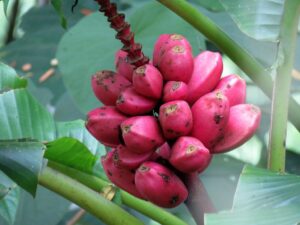Introduction
Have you ever dreamed of adding a number of the top notch elements on your garden? Think of it as a tree with beautiful red bananas that can be a verbal exchange starter and a a laugh addition to your landscape. Growing a pink banana tree might also seem daunting, but with the right recommendations, and you could thrive this particular plant for your backyard.
Why Pink Banana Trees?
Pink banana trees, scientifically referred to as Musa velutina, and aren’t most effective stunning however additionally useful. These timber can beautify your lawn with their colorful colors and tropical appearance. Plus, it makes you experience performed and terrific as you develop them and ultimately undergo fruit.
Benefits of Growing a Pink Banana Tree
- Aesthetic: It gives your garden a heat sense.
- Unusual fruits: Pink bananas are fit for human consumption and can be utilized in a number of cooking dishes.
- Conversation starters: Rare plant life to draw site visitors. Understanding the Pink Banana Tree
Origins and Background
The crimson banana tree hails from Southeast Asia and is idea for its hanging red fruit and luxurious foliage. It’s a small to medium-sized tree that can adapt to distinctive environments, and making it a flexible addition for your lawn.
Unique Characteristics
- Colorful Fruit: Bright pink bananas that stand out.
- Ornamental Leaves: Large, green leaves that add to its tropical charm.
- Compact Size: Typically grows between 4-8 feet tall, or suitable for smaller gardens.
Choosing the Right Spot
Climate Requirements
Pink banana timber develop properly in warm, and humid climates. They are excellent ideal for USDA zones September 11. If you stay in a colder weather, and you may develop them, however you have to be extra careful during the iciness months.
Sunlight and Shade
These timber love sunlight. Ensure they get as a minimum 6-8 hours of direct daylight each day. However, they could tolerate a few shade, and mainly at some stage in the most up to date part of the day.
Soil Preparation
Soil Type
Pink banana plants like well-drained soil. Sand faults are ideal, and but can also grow in clay soil with good drainage.
pH Levels
Aim for a slightly acidic to impartial pH stage, and around five.5 to 7.Zero. Testing your soil’s pH earlier than planting let you make necessary changes.
Enhancing Soil Quality
Upgrade your soil with the help of counting normal tally like compost or properly-rotted fertilizer. This improves soil fertility and drainage, or imparting a higher developing environment to your tree.
Planting the Pink Banana Tree
Selecting Healthy Seeds or Saplings
Choose seeds or saplings from reliable nurseries. Healthy seeds should be plump and loose from mildew. If opting for saplings, and search for ones with healthy, green leaves and a sturdy root gadget.
Step-by-Step Planting Guide
- Prepare the Soil: Dig a hole twice the scale of the basis ball or seed.
- Plant the Tree: Place the seed or sapling inside the hollow, ensuring it’s on the same intensity as it turned into in the nursery pot.
- Backfill and Water: Fill the hollow with soil, and gently firm it down, and water very well.
Watering NeedsHow Often to Water
Water your pink banana tree regularly, or especially during the dry season. They always prefer wet soil but avoid runoff.
Signs of Overwatering and Underwatering
- Overwatering: Yellowing leaves and root rot.
- Underwatering: Wilting leaves and sluggish growth.
Fertilizing Your Pink Banana Tree
Best Fertilizers to Use
Use a proper fertilizers with a estimated ratio like 10-10-10. Organic options which include compost tea or fish emulsion are also powerful.
Fertilizing Schedule
Fertilize each four-6 weeks during the developing season (spring to past due summer). Reduce feeding in the course of the dormant wintry weather months.
You can also read Be Aware Of The Use Of Fertilizer For Plants And Flowers
Pruning and Maintenance
How to Prune Effectively
Remove dead or broken leaves frequently. Prune any suckers (small shoots) that seem at the bottom to encourage the primary stem’s increase.
Regular Maintenance Tips
- Mulching: Apply a layer of mulch or mulching across the base to make and preserve moisture.
- Weeding: Keep the region round your tree unfastened from weeds to reduce opposition for nutrients.
Dealing with Pests and Diseases
Common Pests
- Aphids: Small pest and insects that suck sap from the leaves.
- Spider Mites: Tiny pests that purpose yellowing and stippling on leaves or leaf’s.
Natural Remedies and Preventive Measures
- Neem Oil: Effective against many common pests, insects and bugs.
- Insecticidal Soap: A secure alternative for controlling pests without harming bugs.
Protecting Your Tree in Different Seasons
Winter Care
If you live in a colder weather, defend your tree via bringing it interior or masking it with frost cloths. Reduce watering to prevent root rot.
Summer Care
Ensure your tree receives ok water and offer coloration at some point of the freshest components of the day to save you leaf burn.
Harvesting Pink Bananas
Knowing When to Harvest
Pink bananas are ready to reap while the fruit is absolutely colored and barely gentle to touch.
How to Harvest Without Damaging the Tree
Cut the fruit cluster carefully with a sharp knife. Avoid pulling or yanking the fruit, and as this can harm the plant.
Using Pink Bananas
Culinary Uses
Pink bananas may be eaten fresh or utilized in smoothies, cakes, and salads. They have a candy, tangy taste that adds a unique twist to dishes.
Other Creative Uses
- Decorative Arrangements: Use the fruit and leaves in floral arrangements for a tropical touch.
Common Mistakes to Avoid
Overwatering
Too a good deal water can cause root rot. Ensure proper drainage and alter your watering schedule primarily based on weather conditions.
Ignoring Soil Quality
Poor soil high-quality can preclude growth. Always take a look at and amend your soil before planting.
Conclusion
Growing a purple banana tree on your yard may be a worthwhile and visually lovely experience. By following these easy recommendations, you can experience the splendor and specific attraction of this tropical plant. So why no longer deliver it a attempt to upload a touch of red to your lawn.
If you want to have one, than order it on Amazon by clicking on icon.
FAQs
- What zones are suitable for growing purple banana bushes?
O Pink banana bushes thrive in USDA zones Sep 11.
- How lengthy does it take for a pink banana tree to endure fruit?
O It generally takes about 12-18 months for a pink banana tree to endure fruit.
- Can crimson banana timber be grown in boxes?
O Yes, they may be grown in containers, and which makes it less difficult to transport them indoors at some stage in chillier months.
- Are crimson bananas safe to eat?
O Yes, red bananas are edible, or despite the fact that they comprise hard seeds.
- How tall do pink banana bushes develop?
O Pink banana timber generally develop between 4-eight feet tall, and making them appropriate for smaller gardens.



